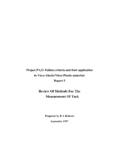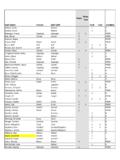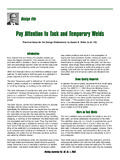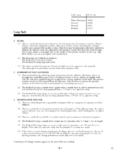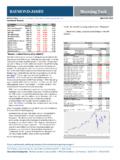Transcription of Measurement Good Practice Guide No. 26 Adhesive Tack
1 Measurement good Practice Guide No. 26 Adhesive TackBruce Duncan*, Steve Abbott+ and Richard Roberts** Centre for Materials Measurement and Technology,National Physical Laboratory, Teddington.+ SATRA, Kettering.** Pira International, : Adhesive tack is the property that controls the instant formation of a bond when an adhesiveand a surface are brought into contact. Although tack test methods are generally simple toperform, obtaining reliable measurements can be a problem. This Guide is intended to giveguidance on the Measurement of the tack of permanently tacky pressure sensitive adhesives(including tapes) and adhesives whose tack requires activation in some way. Standard testmethods for pressure sensitive adhesives (rolling ball, loop tack , probe tack and quick stick)are discussed. A study of a tack Measurement method for the footwear industry is presentedas a case study that illustrates the issues involved in measuring the tack of activatedadhesives.
2 Crown Copyright 1999 Reproduced by permission of the Controller of HMSOISSN 1368-6550 July 1999 National Physical LaboratoryTeddington, Middlesex, UK, TW11 0 LWThis Guide has been produced in a Performance of Adhesive Joints project, part of theMaterials Measurement programme sponsored by the Engineering Industries Directorate ofthe Department of Trade and Industry. The advice and guidance from Gareth McGrath(TWI) and the Adhesives Industrial Advisory Group are gratefully Guide was produced as part of a collaboration between SATRA (Shoe and Allied TradesResearch Association), Pira International (Packaging Industry Research Association and theNational Physical Laboratory (NPL). The authors would like to acknowledge thecontributions of their colleagues; Lewis Lay (NPL), Abayomi Olusanya (NPL), PhilBarraclough (SATRA), Andy Bingham (SATRA) and David Shires (Pira International).)
3 For further information on Materials Measurement contact the Materials Enquiry Point at theNational Physical Laboratory:Tel:0181 943 6701 Fax:0181 943 good Practice Guide No. 26 Adhesive TackContentsExecutive of Preparation and for Pressure Sensitive Ball tack tack Stick for Activated of Robin Assessment of Loop tack of and Further I: Factors Influencing II: Data from tack good Practice Guide No. 261 Adhesive TackExecutive SummaryThis Measurement Guide aims to provide guidance to technologists, laboratory and qualityassurance personnel on how to select and perform measurements to determine the tack ofadhesives and Adhesive tack . Some general familiarity with laboratory operations, but notspecifically adhesives testing, is assumed. The objective of this Guide is to familiarise theoperator with the options available for testing and the factors that can influence the tackresults.
4 tack Measurement procedures should be selected according to the application of thedata. Procedures for tack tests should be developed which cover the application and theequipment used. Often, additional controls than are called for in standard measurements mayneed to be specified or deviations from the standards may be needed to produce data that aremore relevant to the bonding is the property of an Adhesive that determines its ability to instantly form a bond withanother surface under light contact pressure. tack is not merely a material property of theadhesive but also depends on the adherend properties and the process conditions. Thus, tackis sensitive to a wide range of factors. tack is one of the most important properties of theadhesive. It is particularly relevant where bonds must immediately sustain load afterassembly.
5 tack Measurement methods tend to be application specific. In general, Measurement methods do not control all the factors influencing tack . Therefore, Measurement uncertainties can be relatively large and measurements made using differentmethods are rarely Guide describes some of the most common test methods for determining the tack ofpressure sensitive adhesives (PSAs). PSAs are adhesives that are permanently tacky and willstick to a variety of surfaces under light pressure. Standard tests for tack of PSAs fall intofour categories: rolling ball, loop tack , probe tack and quick stick. The merits of, andpotential problems with, each method are discussed. Table 1 summarises the likely areas ofsuitability of each test adhesives, other than PSAs, require some form of activation, for example through heator moisture, before they become tacky.
6 The tack of such systems will depend upon theactivation conditions and the history of the sample after activation. The techniquesdeveloped for activated adhesives tend to be based on the bonding process in which they areused. Many methods have been developed in different industries. Rather than discuss thesemethods individually, a tack Measurement method used in the footwear industry has beenused to illustrate some of the issues influencing the results. Appendix I summarises theimportant factors that will influence the tack tends to be a more variable property than other properties of the Adhesive since itdepends on so many different factors. It is difficult to control all of these. Some results froma round robin exercise on the loop tack test and an intercomparison between different tackmeasurement methods are presented to illustrate the likely degree of accuracy that may beexpected from good Practice Guide No.
7 262 Table 1: tack Method Selection GuideApplicationAdhesive TypePSA TapePSA CoatingActivatedAdhesiveQuality Control(minimal investment orequipment)RBRBQ uality Control(medium investment orequipment )LT, PT, QSLT, PT, QSLT, QSMaterial Selection orSpecificationLT, PT, QSLT, PT, QSLT, QSProcess Development(medium investment orequipment )LT, PT, QSLT, PT, QSProcess Development(higher investment)UDTUDTUDTR esearchLT, PT, QS;UDTLT, PT, QS;UDTLT, PT, QS;UDTKey:minimal investment or equipment:cost of setting up test facilitiesno specialised test equipment available;no specialised Adhesive testing expertise;limited budget (< 500).medium investment or equipment:cost of setting up test facilitiessome equipment available ( motorised test standand force transducer [50 N range, resolution Nor better]);general testing experience;budget up to =Rolling Ball Test (Section )LT =Loop tack Test (Section )PT =Probe tack Test (Section )QS = Quick Stick Test (Section )UDT =User Developed Test - specific to bonding process or application (section 5) - may bebased on an existing standard test (lowest cost option) or a significant good Practice Guide No.
8 tack is the property of an Adhesive that enables it to instantly form a bond whenbrought into contact with another surface (which may be another Adhesive ). Control of tackis important in operations where instant bond strength is needed. However, in manyassembly or packaging applications tack strengths may need to be limited to allow separationand refitting of parts. Adhesive tack depends on; the adhesion between the Adhesive and thesurface, and the cohesive strength of the Adhesive . tack properties are thought to depend onthe visco-elastic characteristics of the polymer adhesives. good Adhesive tack is normallyachieved when the adhesion strength is greater than the cohesive strength of the Adhesive (orthe substrate).The adhesion strength (or the bond between Adhesive and surfaces) is influenced by: surface energies of Adhesive and substrate (depends on materials, preparation, cleaning,contaminants, etc.)
9 ; wetting of the surfaces by the Adhesive (depends on surface energies and the flowproperties of the Adhesive ); the dwell time (longer times allow more of the contact area to be wetted); the contact pressure (higher pressures promote better spreading and wetting);The cohesive strength (or the capability of the Adhesive to resist rupture) is influenced by: the mechanical properties of the Adhesive (modulus, yield strength, strain to failure, visco-elasticity); the failure mode of the Adhesive (brittle or ductile); the proportion of the surface that has been wetted;The adhesion and the cohesive strength that determine the Adhesive tack depend on manyfactors. These properties are influenced by the environmental conditions such as temperatureand tack is important in many bonding applications. Many test measurements have beendevised to assess tack .
10 It should be noted that the test itself can influence the performed in the PAJ programme has demonstrated how selection of test variables,such as separation rates, stiffness of adherends, substrate clamping or standard surface, caninfluence the measurements. Some of the factors that can influence tack are summarised inAppendix Guide focuses on the Measurement of tack for applications where rapid bond strengthformation is required. A glossary of terms is given in Section 2. Guidance on samplepreparation and conditioning issues is given in section 3. The Guide is split into two sectionscovering Measurement methods for the tack of pressure sensitive adhesives (PSAs) that arepermanently tacky and those for tack of adhesives that require activation to become tacky. Itdoes not specifically address measurements for tack of structural adhesives or hot meltadhesives.
